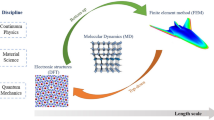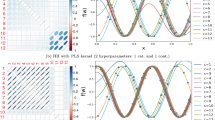Abstract
The moment-independent global sensitivity method is an important branch among the prosperous developments of global sensitivity analysis. It can quantify the influence of input variables on the uncertainty of model output by taking the entire distribution ranges into account. However, the fast and accurate estimation still remains a challenging task in engineering practices. This article aims at developing a robust and efficient sensitivity analysis approach by leveraging the superiority of Bayesian active learning technology. An algorithm called active learning of cumulative distribution function (AL-CDF) is proposed to efficiently derive an accurate CDF of model output with a small group of training data. In AL-CDF algorithm, a modified U-learning function is defined to determine the best point to guide the learning process of CDF. Moreover, an innovative stopping criterion is specially designed based on functional samples of posterior Gaussian process, aided by an advanced Gaussian process generator. Once the AL-CDF is completed, the Bayesian inference of moment-independent indices by empirical-Copula method can be directly applied in a pure statistic manner, with no more evaluations of the complex performance function. From this perspective, the main computational cost is consumed in the AL-CDF procedure. In addition, benefiting from the sampling strategy from posterior GPR model, the posterior variations of moment-independent sensitivity indices can be derived as by-products. Finally, the effectiveness of the proposed work is demonstrated by a nonlinear numerical example, a wing flutter model as well as the NASA Langley multidisciplinary challenge.











Similar content being viewed by others
References
Der Kiureghian A, Ditlevsen O (2009) Aleatory or epistemic? Does it matter? Struct Saf 31(2):105–112
Aven T (2010) On the need for restricting the probabilistic analysis in risk assessments to variability. Risk Anal Int J 30(3):354–360
Zhou C, Shi Z, Kucherenko S, Zhao H (2022) A unified approach for global sensitivity analysis based on active subspace and kriging. Reliab Eng Syst Saf 217:108080
Saltelli A, Ratto M, Andres T, Campolongo F, Cariboni J, Gatelli D, Saisana M, Tarantola S (2008) Global sensitivity analysis: the primer. Wiley, New York
Wang P, Li C, Liu F, Zhou H (2022) Global sensitivity analysis of failure probability of structures with uncertainties of random variable and their distribution parameters. Eng Comput 38(Suppl 5):4367–4385
El Amri MR, Marrel A (2022) Optimized hsic-based tests for sensitivity analysis: application to thermalhydraulic simulation of accidental scenario on nuclear reactor. Qual Reliab Eng Int 38(3):1386–1403
Khan S, Kaklis P, Serani A, Diez M (2022) Geometric moment-dependent global sensitivity analysis without simulation data: application to ship hull form optimisation. Comput Aided Des 151:103339
Wang P, Zhu H, Tian H, Cai G (2021) Analytic target cascading with fuzzy uncertainties based on global sensitivity analysis for overall design of launch vehicle powered by hybrid rocket motor. Aerosp Sci Technol 114:106680
Dasari SK, Cheddad A, Andersson P (2020) Predictive modelling to support sensitivity analysis for robust design in aerospace engineering. Struct Multidiscip Optim 61:2177–2192
Sobol’ IM, Asotsky D, Kreinin A, Kucherenko S (2011) Construction and comparison of high-dimensional Sobol’generators. Wilmott 2011(56):64–79
Owen AB (2013) Better estimation of small sobol’sensitivity indices. ACM Trans Model Comput Simul (TOMACS) 23(2):1–17
Morris MD (1991) Factorial sampling plans for preliminary computational experiments. Technometrics 33(2):161–174
Campolongo F, Cariboni J, Saltelli A (2007) An effective screening design for sensitivity analysis of large models. Environ Model Softw 22(10):1509–1518
Borgonovo E (2007) A new uncertainty importance measure. Reliab Eng Syst Saf 92(6):771–784
Borgonovo E, Plischke E (2016) Sensitivity analysis: a review of recent advances. Eur J Oper Res 248(3):869–887
Derennes P, Morio J, Simatos F (2019) A nonparametric importance sampling estimator for moment independent importance measures. Reliab Eng Syst Saf 187:3–16
Barr J, Rabitz H (2022) A generalized kernel method for global sensitivity analysis. SIAM ASA J Uncertain Quantif 10(1):27–54
Sarazin G, Derennes P, Morio J (2020) Estimation of high-order moment-independent importance measures for shapley value analysis. Appl Math Model 88:396–417
Cucurachi S, Blanco CF, Steubing B, Heijungs R (2022) Implementation of uncertainty analysis and moment-independent global sensitivity analysis for full-scale life cycle assessment models. J Ind Ecol 26(2):374–391
Zhang F, Xu X, Cheng L, Wang L, Liu Z, Zhang L (2019) Global moment-independent sensitivity analysis of single-stage thermoelectric refrigeration system. Energy Res 43:9055–9064
Yun W, Lu Z, Jiang X (2019) An efficient method for moment-independent global sensitivity analysis by dimensional reduction technique and principle of maximum entropy. Reliab Eng Syst Saf 187:174–182
Novák L (2022) On distribution-based global sensitivity analysis by polynomial chaos expansion. Comput Struct 267:106808
Wei P, Lu Z, Yuan X (2013) Monte Carlo simulation for moment-independent sensitivity analysis. Reliab Eng Syst Saf 110:60–67
Wei P, Lu Z, Song J (2014) Moment-independent sensitivity analysis using copula. Risk Anal 34(2):210–222
Han M, Huang Q, Ouyang L, Zhao X (2023) A kriging-based active learning algorithm for contour estimation of integrated response with noise factors. Eng Comput 39:1341–1362
Kushari S, Mukhopadhyay T, Chakraborty A, Maity S, Dey S (2022) Probability-based unified sensitivity analysis for multi-objective performances of composite laminates: a surrogate-assisted approach. Compos Struct 294:115559
Song J, Wei P, Valdebenito MA, Faes M, Beer M (2022) Data-driven and active learning of variance-based sensitivity indices with Bayesian probabilistic integration. Mech Syst Signal Process 163:108106
Wolff EF (1980) N-dimensional measures of dependence. Stochastica 4(3):175–188
Wei P, Zheng Y, Fu J, Xu Y, Gao W (2023) An expected integrated error reduction function for accelerating Bayesian active learning of failure probability. Reliab Eng Syst Saf 231:108971
Nelsen RB (2007) An introduction to copulas. Springer science & business media, Berlin
Genest C, Favre A-C (2007) Everything you always wanted to know about copula modeling but were afraid to ask. J Hydrol Eng 12(4):347–368
Botev ZI, Grotowski JF, Kroese DP (2010) Kernel density estimation via diffusion. Ann Stat 38(5):2916–2957
Rasmussen CE, Williams CKI (2006) Gaussian Processes for Machine Learning. The MIT Press, Cambridge
Le Gratiet L, Cannamela C, Iooss B (2014) A Bayesian approach for global sensitivity analysis of (multifidelity) computer codes. SIAM ASA J Uncertain Quantif 2(1):336–363
Chen J, Sun W, Li J, Xu J (2013) Stochastic harmonic function representation of stochastic processes. J Appl Mech 80(1):011001
Zhao N, Huang G, Kareem A, Li Y, Peng L (2021) Simulation of ergodic multivariate stochastic processes: an enhanced spectral representation method. Mech Syst Signal Process 161:107949
Huang S, Quek S, Phoon K (2001) Convergence study of the truncated Karhunen–Loeve expansion for simulation of stochastic processes. Int J Numer Methods Eng 52(9):1029–1043
Echard B, Gayton N, Lemaire M (2011) AK-MCS: an active learning reliability method combining kriging and monte carlo simulation. Struct Saf 33(2):145–154
He W, Li G, Zhong C, Wang Y (2023) A novel data-driven sparse polynomial chaos expansion for high-dimensional problems based on active subspace and sparse bayesian learning. Struct Multidiscip Optim 66(1):29
Ye Z, Zhang W, Shi A et al (2010) Fundamentals of fluid-structure coupling and its application. Harbin Institute of Technology Press, Beijing
Crespo LG, Kenny SP, Giesy DP (2014) The Nasa Langley multidisciplinary uncertainty quantification challenge. 16th AIAA Non-deterministic approaches conference, 13–17 January, Maryland, 1347
Patelli E, Alvarez DA, Broggi M, Angelis M (2015) Uncertainty management in multidisciplinary design of critical safety systems. J Aerosp Inf Syst 12(1):140–169
Bi S, Broggi M, Wei P, Beer M (2019) The bhattacharyya distance: enriching the p-box in stochastic sensitivity analysis. Mech Syst Signal Process 129:265–281
Acknowledgements
This work is supported by the National Natural Science Foundation of China under Grant numbers 12202358 and the Fundamental Research Funds for the Central Universities. The first author is supported by the Qin Chuangyuan high-level innovation and entrepreneurship talent projects (2023–2025) in Shannxi Province of China.
Author information
Authors and Affiliations
Corresponding author
Ethics declarations
Conflict of interest
The authors declare that they have no any competing interests.
Additional information
Publisher's Note
Springer Nature remains neutral with regard to jurisdictional claims in published maps and institutional affiliations.
Rights and permissions
Springer Nature or its licensor (e.g. a society or other partner) holds exclusive rights to this article under a publishing agreement with the author(s) or other rightsholder(s); author self-archiving of the accepted manuscript version of this article is solely governed by the terms of such publishing agreement and applicable law.
About this article
Cite this article
Song, J., Zhang, Y., Cui, Y. et al. Bayesian active learning approach for estimation of empirical copula-based moment-independent sensitivity indices. Engineering with Computers 40, 1247–1263 (2024). https://doi.org/10.1007/s00366-023-01865-0
Received:
Accepted:
Published:
Issue Date:
DOI: https://doi.org/10.1007/s00366-023-01865-0




